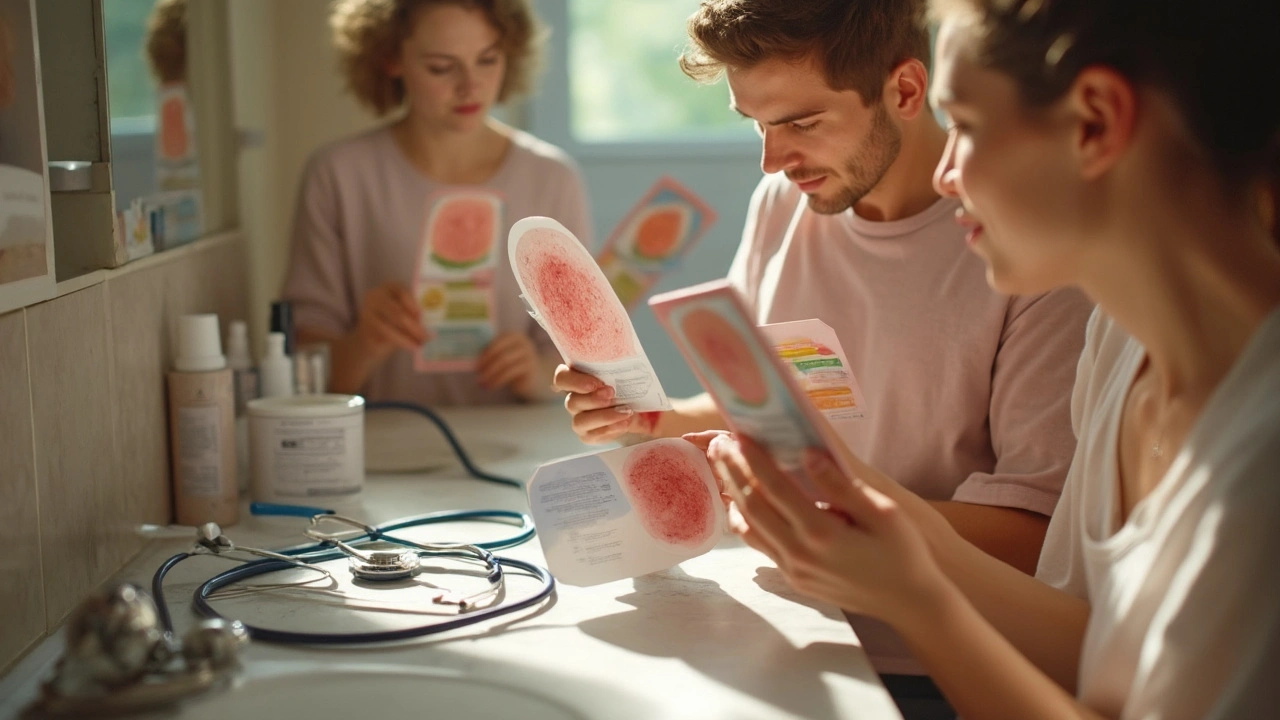Skin Yeast Infection Diagnosis: Why Getting It Right Matters
 May, 14 2025
May, 14 2025
Red, itchy skin always grabs your attention. But it’s easy to misread what the skin is actually saying. One common culprit, the yeast infection, loves to play dress-up as just about any skin rash you can think of—eczema, psoriasis, ringworm, or even plain old dry skin. Miss it, and you end up in an endless cycle of creams and lotions that don’t do squat. All the while, the real problem—overgrowth of that fungus called Candida—keeps quietly spreading. Here’s the wild part: research shows up to 70% of people with chronic, mysterious skin rashes have at least traces of yeast lurking, but most don’t realize it until the rash just won’t quit.
When Skin Yeast Infections Go Under the Radar
Ever had a rash that just sticks around, despite everything you try? Yeast infections thrive in spots your sweat gathers—think armpits, groin, the space between your toes, or those creases around your belly or under your bust. The main culprit, Candida albicans, is a fungus that’s actually supposed to be on your skin in small amounts, just hanging out, causing no trouble. Trouble starts when things get warm, damp, or your immune system takes a little vacation. Suddenly, the yeast multiplies like mad. But here’s the kicker: in the early stages, these infections might look almost identical to some common skin conditions.
Take a closer look at how yeast shows up compared to other rashes you might confuse them with:
| Condition | Typical Appearance | Common Location |
|---|---|---|
| Yeast Infection | Red, itchy, sometimes has satellite pustules | Folds, warm/moist skin |
| Eczema | Itchy, dry, flaky patches | Elbows, knees, hands |
| Psoriasis | Silvery, scaly plaques, less moist | Scalp, elbows, knees |
| Ringworm | Ring-shaped, raised borders | Anywhere – classic circular look |
Doctors admit it’s not unusual to see yeast diagnosed as eczema or ringworm, leading to steroid creams that thin your skin and actually help the yeast, not you. I once saw my cousin go through four tubes of steroid cream before someone finally swabbed her rash and sent it to the lab. Turns out, those steroids just cleared the redness for a day, then the fungus came roaring back. The longer your diagnosis is off, the longer you itch and the riskier it gets: the infection might spread, crack the skin, and fast-track bacteria right in—a double whammy.
So, if you ever have a rash that:
- Keeps showing up in skin folds
- Seems worse after steroid creams
- Has tiny red "satellite" bumps outside the main rash area
- Feels itchy, sore, and just won’t quit
…it’s time to consider yeast as the hidden troublemaker.

The Science of Getting the Diagnosis Right
Want to know the real secret weapon against misdiagnosis? Swabbing and testing the area for yeast. It’s not fancy, just basic science: a cotton swab collects some skin (or the gooey stuff on it), goes to a lab, and, if yeast is partying there, it’ll be found under a microscope or grown out in a little dish. Sure, this takes a couple of days, but wouldn’t you rather have an answer than keep guessing?
Some doctors try a "treatment trial"—they guess it’s yeast and toss an antifungal cream at it. Sometimes, that works, and the rash goes away. But here’s the dangerous part: if your skin issue isn’t yeast (say, it’s actually eczema or an allergic reaction), antifungal creams can dry things out, burn, and make matters worse. A real diagnosis means getting the right fix fast. Plus, if it’s a stubborn or widespread yeast problem, creams won’t cut it—a pill may be needed, especially for people with weakened immune systems, diabetes, or those on certain medications.
Here are clues that can push a doctor to think beyond the usual rashes and test for yeast:
- The rash sticks to moist, folded skin (under arms, groin, under breasts, between toes)
- Bright red color, sometimes peeling at the edges or with small bumps nearby
- Itchiness or burning that seems out of proportion to the rash’s size
- A history of repeated rashes that flare up with heat or sweat
- Getting little to no relief from steroids or regular lotion
Doctors use a few common lab tricks:
- KOH prep: A drop of potassium hydroxide put on the sample dissolves skin cells but leaves yeast visible under the microscope. It’s fast—results in under 10 minutes.
- Fungal culture: They try to grow the yeast in a dish, which tells not only if yeast is there but sometimes what kind—there are several types besides Candida albicans that need different meds.
- Biopsy: Rare, but sometimes a tiny skin sample needs to go under close examination, especially if nothing else makes sense.
If you’re ever in the exam room, and your doctor just glances then prescribes steroids, speak up. Ask: “Could this be yeast? Can we check?” No doctor should mind a good question. Your skin will thank you.

What Happens When Yeast Infections are Treated Early vs. Late
The payoff for a quick, spot-on diagnosis? Fast, sometimes complete relief. People who get the right treatment—say, an antifungal cream for a mild rash—can notice improvement in as little as 3 days. Left untreated or misdiagnosed, yeast rashes morph into bigger headaches. I’ve seen cases spread from one skin fold to another, or crack open, letting bacteria in and leading to staph infections. Diabetes, obesity, being on antibiotics, or having a weak immune system make yeast much more likely to take over and much harder to treat.
If you have a furry pal like my dog Pixel, you know pets can catch and spread yeast, too—especially dogs with droopy ears and lots of skin folds. People often get it from moist towels, shared sheets, or gym equipment. Fun fact: fungi love sweaty socks! Kids get yeast rashes, too, especially after antibiotics clear out the regular bacteria in their gut and on their skin—leaving more room for yeast to move in. Rashes on babies’ bottoms? Sometimes it’s diaper rash, but if it doesn’t respond to basic diaper creams, suspect yeast (and ask your pediatrician to test).
Here are some solid, science-backed tips you probably won’t hear at an urgent care walk-in:
- Change out of sweaty clothes and dry off quickly, especially after exercise or the sauna.
- Use unscented soap and skip fancy lotions—perfumes can irritate infected skin.
- Keep folds clean and dry; powder (cornstarch, not talcum) can help but don’t overdo it.
- If you’re using antibiotics or steroids, keep a sharp eye on new rashes. Immune shifts make yeast pop up fast.
- If you get repeat infections, ask your doc to check your blood sugar—yeast absolutely loves high sugar.
- Keep pets clean and talk to your vet if you notice them scratching the same spot over and over.
Urging friends to "just try this antifungal cream" won’t help if it’s not really yeast. The wrong diagnosis wastes time, and misused medications (like steroids or antibiotics) cause bigger headaches later. Every skincare aisle has row after row of miracle cures, but without checking what’s causing the rash, it’s a shot in the dark.
If you’re dealing with a mystery rash and reading this while endlessly Googling for answers, don’t hesitate to nudge your doctor for a real test. Swabs are quick, painless, and can save you months of discomfort. Remember, skin yeast infections aren’t a sign of bad hygiene—they’re just opportunists waiting for their moment. You don’t have to put up with stubborn rashes, confusing advice, and the itch that won’t quit. Get the diagnosis right from the start, and you’ll likely get relief a whole lot faster.
Cori Azbill
May 19, 2025 AT 09:20Paul Orozco
May 19, 2025 AT 20:42Bobby Marshall
May 20, 2025 AT 05:15Ardith Franklin
May 21, 2025 AT 16:52Jenny Kohinski
May 23, 2025 AT 01:29Aneesh M Joseph
May 23, 2025 AT 10:20Deon Mangan
May 25, 2025 AT 05:57Vinicha Yustisie Rani
May 25, 2025 AT 19:36Carlo Sprouse
May 26, 2025 AT 15:33